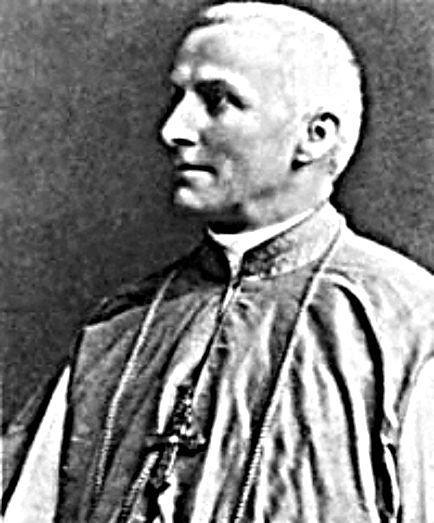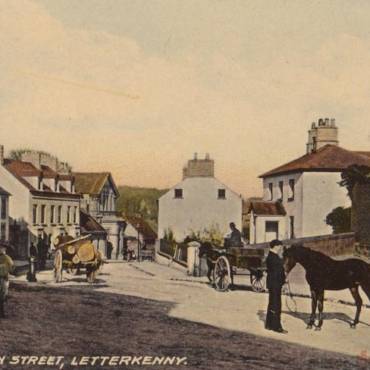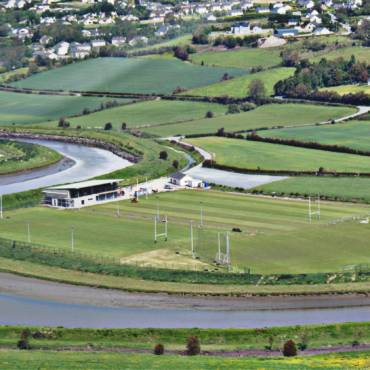Cardinal Patrick O’Donnell 1856-1927
Many visitors, and indeed locals, have seen the large statue outside the Cathedral and wondered who exactly was this man that warranted a statue in his likeness to be erected in the town. Unveiled by Bishop William McNeely in 1929, the statue is of Cardinal Patrick O’Donnell, the former Bishop of Raphoe who supervised the completion of not just the Cathedral, but also St. Eunan’s College and both the Presentation Brothers and Loreto Nuns primary schools.
Patrick O’Donnell was born on 28th November 1856 in Kilraine near Glenties, the son of Dan O’Donnell and Mary Breslin. Following national schooling in Kilraine, Patrick attended the High School in Letterkenny in the Old Seminary on the Main Street before attending the Catholic University in Dublin and the seminary in Maynooth. It was here that he was ordained a priest in July 1880. It is quite a testament to his ability and determination that he was consecrated as Bishop of Raphoe on 3 April 1888, only eight years after his ordination as a priest and became the youngest ever Bishop in the world at the time at the age of 32.
A keen Nationalist, O’Donnell was not only involved in the day to day running of his diocese but he was also involved in the Plan of Campaign and Congested Districts Board to aid his parishioners and his fellow countrymen in their struggles against landlordism.
However, Bishop O’Donnell’s primary focus was on the building of a Cathedral, which he knew would cost a large amount of money in very tough times. In 1890, the Cathedral Building Committee was formed and despite the bleak economic conditions prevalent at the time in Donegal, Bishop O’Donnell called on generous people, especially of Irish descent, all over the world to help with the fund. What he wanted most of all was:
“a building to gladden the hearts and ennoble the ideas of our downtrodden race, and remain for ages, not only a memorial, but a resurrection of the fallen shrines of Donegal.”
By June of 1901 the new Cathedral was ready for opening. People came from all parts of Ireland, England, Scotland, America, Australia and New Zealand to witness this wonderful occasion for the town of Letterkenny and the overall Diocese of Raphoe. The consecration took place on Friday June 14thby Cardinal Logue while the first mass took place at 11 o’clock on Sunday June 16th1901.
Bishop O’Donnell continued to be involved with national politics after the Cathedral was completed. He had been friends with John Dillon MP since his university days and was a key supporter of the Home Rule movement and the Irish Parliamentary Party. He even helped to unify the party following the split after the scandal of Charles Stewart Parnell’s affair with Kitty O’Shea in 1891. When the prospect of partition loomed in 1912, he was an advisor to John Redmond on the best political stance to take and he was chosen as key speaker at the Irish Convention of 1917-18 which was set up to decide on the best solution to the ‘Irish Question’. Having been a member of the Congested Districts Board since 1892, he was its longest serving member until its dissolution in 1923.
He became co-adjutator Archbishop of Armagh in 1922 and Archbishop in 1924, with Fr. William MacNeely, from Donegal Town succeeding him as Bishop of Raphoe. In 1925, he was appointed Cardinal but he died on 22nd October 1927 at the age of 71. While on holiday in Carlingford, Co. Louth, he had been out swimming and injured his knee, which led him to develop double pneumonia and pleurisy. His death was mourned not just in his adopted hometown of Letterkenny but throughout the country. He is buried in Armagh.
It is sometimes easy to forget the impact that Patrick O’Donnell had on national politics as a whole and the esteem in which he was held in but also the sizeable impact he had on our local history. His role in the development of education in Letterkenny at the dawn of the twentieth century was evidenced by the supervision of the opening of St. Eunan’s Presentation Brothers School (1896), St. Columba’s Convent National School (1898), St. Eunan’s College (1906) and the Technical School (1914) while his love of the preservation of the Gaelic language is evidenced by his promotion of the Aonach Tir Chonaill (1898) which continued in various venues throughout the county until the 1950s as well as the publication of An Crann, the journal of the Crann Eithne movement. His greatest legacy, however, is without doubt the beautiful structure that dominates the hillside town of Letterkenny and captures the attention of all who visit here, the Cathedral of Saints Eunan and Columba.



